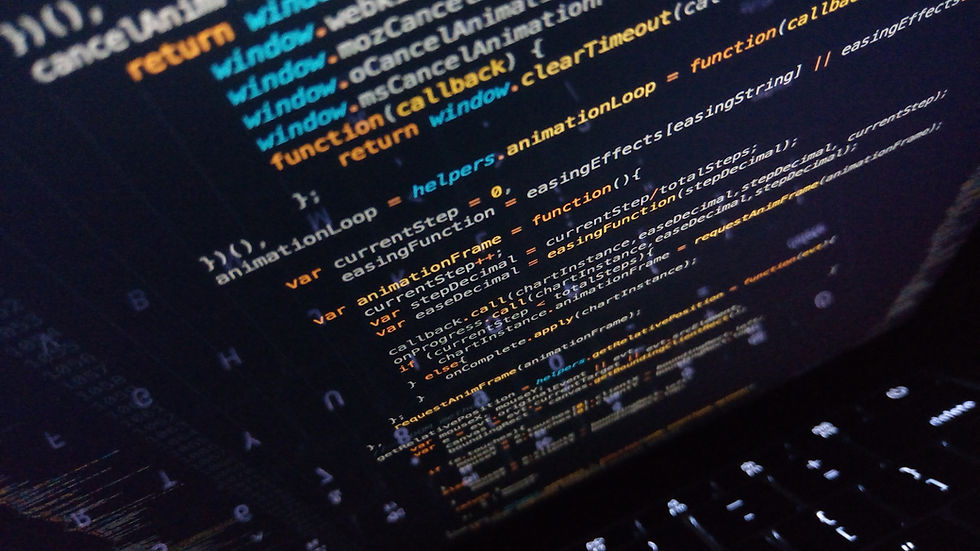Building a Basic C++ Application from Scratch: A Step-by-Step Guide to Acclimate
- McCoyAle

- Feb 4
- 5 min read
Updated: Feb 14
C++ is a powerful programming language that has stood the test of time. C++ combines object-oriented, generic, and functional programming features with low-level memory manipulation capabilities. The versatility of the language makes it better suited for developing diverse applications, including system software, game development, embedded systems, and high-performance computing. It is also a compiled language, which sets the requirement for source code being translate prior to compilation. C++ is a more challenging programming language due to increasing proficiency and performance metrics through providing programmings with increased control over system resources and memory.
If you are new to C++ or looking to sharpen your skills, building a simple application that solves a problem within your local workstation or server, or tackling a problem you experience in daily life operations, can be a great starting point. Let's take a moment to understand configuring C++ to build a simple application.
Setting Up Your Development Environment
Before diving into coding, it's crucial to have the right tools at your disposal.
Choose an IDE: Integrated Development Environments (IDEs) like Visual Studio, Code::Blocks, or CLion provide code editors, debuggers, and other useful tools in one package.
Note: Understanding how a language learns via the local terminal remains an important component to many developers and engineers. If this is you, please understand installing an IDE is optional. If you are just starting out, navigating the terminal with a language like C++ will improve your ability to embed fundamental learnings.
Install a Compiler: Ensure that you have a C++ compiler installed on your machine. If you’re using an IDE, it often comes with one. GCC (GNU Compiler Collection) is a popular choice for many developers.
Note: This step heavily depends on the operating system in use. For MacOS, you'll want to use Homebrew or Xcode. Windows and Linux will use their respective package managers.
Method 1: Using Xcode and Command-Line Tools
Open the App Store and install Xcode .Open Terminal: (located in /Applications/Utilities).Run the command xcode-select --install .Click "Install": when prompted to download and install the Command Line Tools.Agree to the license agreement .Click "Done": after the installation completes. Method 2: Using Homebrew (for GCC or Clang)
Install Homebrew: if you don't have it already (follow the instructions on the Homebrew website).Open Terminal .Install GCC: brew install gcc.Install Clang: brew install clang. Set Up Your Project: Open your IDE and create a new project. This is where all your files will be organized. Generally, you will create a console application for this basic project.
Note: If you opt for the terminal, create your project local and push to a remote repository such as Github.
Understanding the Project Structure
When you create a new project, you'll typically see a folder structure that includes:
Source Files: This is where your C++ code files (usually ending in .cpp) will be stored.
Header Files: Here, you will place your header files (ending in .h) that declare functions and classes.
Build Configuration: This contains settings related to compiling your application.
Getting familiar with this structure will make it easier to manage your code for future scalability.
Writing Your First C++ Program
Now that you have your development environment set up, it's time to write your first simple application.
Create a New Source File: Right-click on the Source Files directory in your IDE and select “Add New Item” or similar option.
Code Your Application: Open the newly created file and start writing your code. Below is a basic C++ program that takes user input and displays a greeting:
cppinclude <iostream>include <string>int main() { std::string name; std::cout << "Enter your name: "; std::getline(std::cin, name); std::cout << "Hello, " << name << "! Welcome to your first C++ application!" << std::endl; return 0;}In this program, we are using `iostream` to handle input and output, and `string` to manage text.
Save Your File: Save your source code file with a meaningful name, like `main.cpp`.
Compiling Your Application
Once you have written your code, the next step is to compile it into an executable format.
Build the Project: Use the built-in functionality in your IDE to “build” or “compile” the project. This process will check for syntax errors and create an executable file if successful.
Check for Errors: If there are errors, read the messages provided by your compiler and fix them before proceeding.
Run the Application: After successfully compiling, run your application. The console window should open, and you will see the prompt asking for your name.
Note: If you are working in the terminal, you'll need to execute a command like so:
clang++ -std=c++14 main.cpp -o WelcomeApp //Execute to compile and build the application executable file. ./WelcomeApp //Use and the name of the file without the .cpp extension.Testing Your Application
Once your application is running, it’s important to test its functionality.
Input Different Names: Try entering different names to see how the program responds.
Edge Cases: Test for edge cases, such as entering an empty string or unusual characters. This will help ensure that your application can handle unexpected inputs gracefully.
Expanding Your Application
Now that you have a basic application, it's time to think about expanding its functionality. Here are a few ideas to get you started:
Add More Features: Consider asking users for their age or favorite color and incorporate that into your greeting. You can even turn it into a contact list to save contact information.
Create Functions: Break your code into functions to make it more organized. This not only enhances readability but also allows for easier debugging.
Error Handling: Implement error handling to manage user inputs more effectively. This will improve user experience.
Debugging Your Code
Debugging is an essential part of the development process.
Use Debugging Tools: Most IDEs come with debugging tools. You can set breakpoints, which allow you to pause the execution of your application and inspect the program state.
Read Error Messages: When bugs arise, read the error messages carefully. They often give you clues about what went wrong and where to look in your code.
Test After Changes: Each time you make a change to your code, compile and run the application to see if it resolves the issue and doesn’t introduce new bugs.
Final Thoughts
Building a basic C++ application from source, while learning C++ or brushing up on its environment is a great way to get start. It helps to embed the fundamentals improving your ability to function when you upskill and begin to incorporate integration tools such as IDE's, automation pipelines, and other application and platform solutions. When transitioning into a new role, you're not likely to code from scratch unless you're writing scripts or architecting a new solution. Therefore its imperative to identify ways to maintain certain skills and embed the fundamentals, to better navigate source code that was written by another engineer within an ord, during troubleshooting and debugging sessions.
In addition, expanding your projects this way will encourage ongoing experimenting, testing, and skill development to transition knowledge into your development role. Although challenging, the journey into C++ development can be both enjoyable and fulfilling.
Remember, every great programmer started out just like you, building simple applications and gradually developing their skills. Happy coding!





Comments